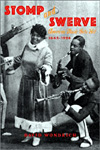




 |
 |
Hot and Cool
Stomp and Swerve tackles American music at the turn of the last century
by Jonathan Frey
“The Rolling Stones are hot, at least through Exile on Main St. The Beatles are usually not, and often anything but (“When I’m Sixty-Four”). James Brown is very hot, James Taylor is not at all. Jimi Hendrix is hot, Pink Floyd is cool for a while, and then just uncool. Nirvana is hot, despite its cool name. Merle Haggard and George Jones are hot, Alabama and the entire cast of the CMA are not.” And with that provocative verdict, David Wondrich in Stomp and Swerve: American Music Gets Hot, 1843 – 1924 (A Cappella, $18) proceeds to capture an 80-year period in American music, further to tracing an unbroken “line of influence from antebellum minstrel Daniel Decatur Emmett to Kid Rock, from Bert Williams, the first black man to appear in a Broadway show, to Outkast,” to establish the roots of what makes American music unique today.

As history, Stomp and Swerve and its companion CD (Archeophone) of the same name comprise an admirable attempt at documenting a murky period in American music. Recording technology didn’t become available until the 1870s, well into the fourth decade covered in this volume. Moreover, the music and times Wondrich covers are largely untranscribed, unwritten, as this is the music and times not of “Topworld” (Wondrich’s term for mainstream America), but rather of Underworld, the disenfranchised, the recently indentured and enslaved. Wondrich follows this music and its emergence, as well as its ultimate reclamation by black culture, through the ‘20s.
That contemporary American music can be sourced to this 80-year period (and presumably to influences from an earlier time as well) presents an obvious and unremarkable thesis. Unique here, however, is Wondrich’s proposal that a key characteristic of American music, namely its “hotness,” can be traced to 1843 when Daniel Decatur Emmett and his so-called Virginia Minstrels (they were from New York City) first donned blackface and commenced to imitate the instrumentation and customs associated with black slave culture, putting into tectonic motion what eventually became Topworld acceptance of musical influences initially presented as caricature.
As analysis, despite the enlightening historical sleuth work, such a thesis requires heavy lifting from several poorly defined terms. For example, according to Wondrich “hot” is a technical, albeit musically inexact, combination of rhythmic drive (the “stomp” in the title) and an arbitrary, irrational, spontaneous quality (or “swerve”), without both of which a tune simply cannot be hot. Worse yet, Wondrich goes further, offering “you know it when you see it” platitudes. Equally inexact is the definition of what American music is: “Before the Europeans came, there was music. That was truly American music, but it’s not what this book is about. Nor is it about the Spanish music of the Southwest, the French music of the Mississippi Valley, or even the ballads brought here by the English and nurtured in the hollows and hills of Appalachia.... This book is about the music of two subject peoples, brought here by the English and often—if not generally—antagonistic to each other, created between themselves, and, with one of the supreme ironies in cultural history, thrust burning into the American heart ... the music from which jazz and R&B, honky-tonk, country, and bluegrass, have all descended, not to mention soul, rap, and all the various subspecies of rock ‘n’ roll.”
Rhetorical creakiness aside, Wondrich’s account of American musical antecedents makes for absorbing reading/listening: the origins of the banjo (“once a signifier for ‘black,’ came to signify, as it still does, ‘too white’”), the development of ragtime, the role of minstrelsy (a species of American dirty little secret), the emergence of the so-called “race” record, John Philip Sousa’s prescient essay on the recording industry (“The Menace of Mechanical Music”), early “square” music, early swinging music. At times it’s necessary to read through the indigenous racism during this period as manifest especially in the lyrics of the day. In that sense, Stomp and Swerve is not for the squeamish, as it is as much cultural as musical history, shedding light beyond merely what we hear on the radio.

May 13, 2004 • Vol. 14, No. 20
© 2004 Metro Pulse
|
|